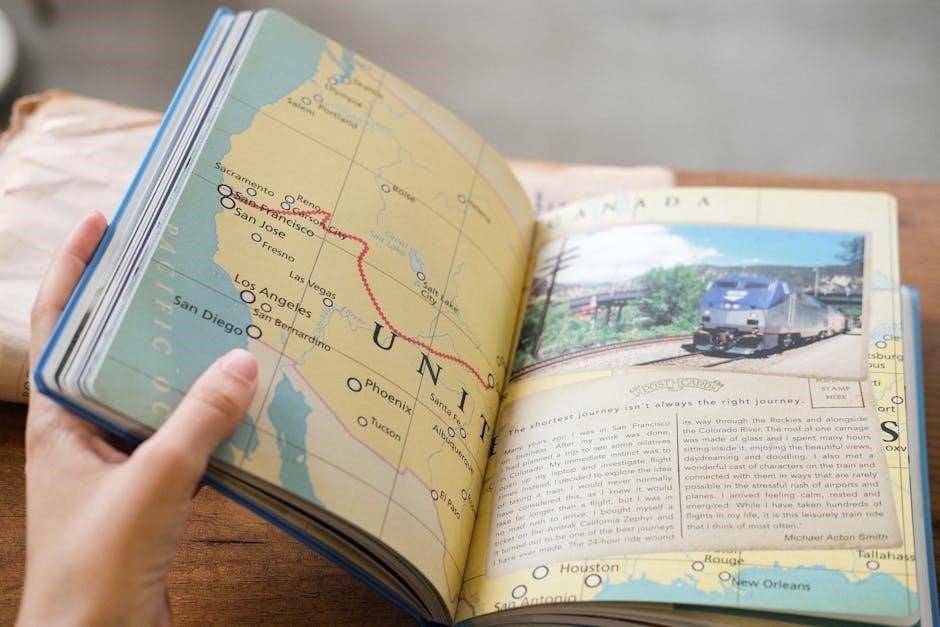
apush unit 7 study guide
APUSH Unit 7 explores the transformative period from 1890 to 1945, covering industrialization, urbanization, Progressive reforms, and global conflicts. Key themes include economic growth, social change, and U.S. emergence as a world power, shaping modern America.
1.1 Overview of Period 7 (1890-1945)
Period 7 spans from 1890 to 1945, marking a transformative era in U.S. history. This period saw the rise of industrialization, urbanization, and the emergence of the United States as a global power. Key events include the Progressive Era, World War I, the Roaring Twenties, the Great Depression, and World War II. These decades were defined by significant social, economic, and political changes, shaping America’s identity and its role on the world stage. Understanding this period is crucial for grasping modern American society and its complexities.
1.2 Key Themes and Concepts
Key themes in APUSH Unit 7 include industrialization, urbanization, Progressivism, and U.S. emergence as a global power. Economic growth, technological advancements, and immigration shaped society, while reforms addressed inequality and corruption. Foreign policy shifts, World War I, and the interwar period highlighted isolationism vs. internationalism. The Great Depression and New Deal showcased government intervention, and World War II solidified U.S. dominance. Cultural changes, such as the Harlem Renaissance and the Roaring Twenties, reflected societal transformations. These themes underscore the complexities of modernization and America’s evolving role in the world.
1.3 Importance of Understanding This Period
Understanding this period is crucial for grasping America’s transformation into a modern, global superpower. It highlights the nation’s struggle to balance tradition with innovation, equality, and economic growth. The era’s challenges, such as industrialization’s social costs and global conflicts, shaped U.S. identity and policy. Studying this period reveals how societal shifts, political reforms, and economic changes laid the foundation for contemporary issues, making it essential for understanding America’s role in the 20th century and beyond.

Industrialization and Urbanization
Industrialization and urbanization transformed America, driving economic growth, technological innovation, and societal change. This era saw the rise of factories, cities, and new social challenges, reshaping the nation.
2.1 The Rise of Big Business and Corporations
The late 19th and early 20th centuries saw the rise of big business, driven by industrialization and technological advancements. Corporations dominated industries like steel and oil, with robber barons like Andrew Carnegie and John D. Rockefeller leading the way. The formation of trusts and monopolies concentrated wealth and power, often at the expense of workers. This era marked the transition from small-scale entrepreneurship to large-scale corporate capitalism, reshaping the U.S. economy and society. Key industries flourished, but labor exploitation and inequality grew, sparking calls for reform.
2.2 Key Industries of the Late 19th and Early 20th Centuries
The late 19th and early 20th centuries were defined by the dominance of steel, oil, and railroad industries. Steel production, led by Andrew Carnegie, revolutionized construction and transportation. The oil industry, controlled by John D. Rockefeller, became a cornerstone of the economy. Railroads expanded nationwide, connecting markets and fostering growth. Additionally, the automobile industry emerged, with Henry Ford pioneering assembly-line production. These industries drove technological innovation, urbanization, and economic transformation, shaping the modern industrial landscape and creating new opportunities for growth and development.
2.3 The Role of Robber Barons

Robber barons, such as Andrew Carnegie, John D. Rockefeller, and Cornelius Vanderbilt, dominated industries like steel, oil, and railroads. They amassed fortunes through aggressive business tactics, often exploiting workers and monopolizing markets. While they drove industrialization and economic growth, their practices led to public backlash and calls for reform. Their philanthropy later shaped public perception, but their influence underscored the tension between capitalism and social responsibility during this transformative era.
2.4 The Impact of Industrialization on Workers
Industrialization brought harsh working conditions for laborers, including long hours, low wages, and unsafe environments. Workers faced exploitation, with minimal job security and few benefits. Immigrants and the poor were disproportionately affected, often forced into unskilled, dangerous roles. Labor unions emerged to challenge these injustices, advocating for better wages and working conditions. Strikes and protests, though sometimes violent, pushed for reforms. Over time, progressive policies and regulations began to address worker exploitation, leading to improved labor standards and protections. This era marked the beginning of the labor rights movement in America.
2.5 Urbanization and Its Challenges
Urbanization during this period led to rapid city growth, driven by industrial jobs and immigration. Overcrowding, poor housing, and inadequate infrastructure plagued urban areas. Immigrants and migrants faced discrimination, limited opportunities, and cultural assimilation pressures. Cities became hubs of social reform, with efforts to address poverty, sanitation, and public health. Political machines like Tammany Hall exploited urban voters, while progressive reforms aimed to improve living conditions. Urbanization also fostered cultural diversity and innovation, shaping the modern American cityscape despite its challenges.

The Progressive Era
The Progressive Era (1890-1920) sought to address social, political, and economic inequalities through reform. Activists and writers pushed for change, influencing policies and public awareness.
3.1 The Progressive Movement: Goals and Ideals
The Progressive Movement aimed to address social, economic, and political inequalities. Its goals included promoting democracy, ensuring social justice, and regulating industrialization’s negative impacts. Progressives sought to empower citizens, reduce corporate influence, and improve living conditions. They emphasized education, transparency, and government accountability. Key ideals were direct primaries, women’s suffrage, and consumer protection. This era marked a shift toward active governance and social reform, laying the groundwork for future policies and societal change.
3.2 Key Progressive Reforms
Key Progressive reforms included trust-busting to break monopolies, the 16th Amendment enabling income tax, and the 17th Amendment for direct Senate elections. The Federal Trade Commission was created to regulate business practices. Labor reforms addressed working conditions, particularly for women and children. Prohibition, though controversial, was another significant reform. Conservation efforts, led by Theodore Roosevelt, aimed to preserve natural resources. These reforms reflected the Progressive commitment to fairness, transparency, and social responsibility, reshaping the nation’s economic and political landscape.
3.3 The Role of Muckrakers
Muckrakers were investigative journalists who exposed corruption and social injustices during the Progressive Era. Their writings sparked public outrage and pushed for reforms. Upton Sinclair’s The Jungle revealed unsanitary meatpacking practices, leading to food safety laws. Ida Tarbell’s exposé on Standard Oil highlighted corporate abuses, promoting antitrust legislation. Muckrakers like Lincoln Steffens and Jacob Riis shed light on urban poverty and political corruption, inspiring change. Their work was crucial in shaping public opinion and driving Progressive reforms, making them key figures in the era’s social and political transformation.
3.4 Progressive Presidents: Theodore Roosevelt, William Howard Taft, and Woodrow Wilson
Theodore Roosevelt championed trust-busting and the Square Deal, targeting corporate monopolies and promoting consumer welfare. William Howard Taft focused on judicial progressivism, though his conservative approach often clashed with Roosevelt. Woodrow Wilson introduced the New Freedom agenda, emphasizing antitrust legislation and financial reform. Together, these presidents advanced Progressive ideals, with Roosevelt and Wilson leaving lasting legacies. Their policies addressed economic inequality, corporate power, and social reforms, shaping the nation’s political landscape during this transformative era.
3.5 The Impact of Progressivism on Society

Progressivism led to significant societal changes, fostering reforms in labor rights, education, and government transparency. It addressed urbanization challenges, improved working conditions, and empowered women through suffrage. The movement also spurred environmental conservation and trust-busting policies. While it faced limitations, such as ongoing racial disparities, Progressivism laid the groundwork for future social and political reforms, reshaping America’s approach to equality and justice during a period of rapid industrial and cultural transformation.

Foreign Policy and Imperialism

The U.S. emerged as a global power, driven by imperialism and strategic interventions. Key events like the Spanish-American War and the Open Door Policy shaped its international role.
4.1 The United States as a Global Power
The late 19th and early 20th centuries marked the U.S.’s rise as a global power. Economic growth, military expansion, and technological advancements enabled the nation to exert influence worldwide. The Spanish-American War showcased its emergence, while the Open Door Policy highlighted its interest in Asia. World War I solidified its role as a key international actor. However, this newfound power brought challenges, including balancing imperialism with democratic ideals and addressing global conflicts responsibly.
4.2 The Spanish-American War and Its Consequences
The Spanish-American War (1898) was sparked by U.S. support for Cuban independence and the explosion of the USS Maine. The war ended quickly, with the U.S. defeating Spain, resulting in the Treaty of Paris. The U.S. gained control of Puerto Rico, Guam, and the Philippines, establishing itself as a global power. However, managing these territories raised questions about imperialism, self-determination, and racial equality, shaping debates over America’s role in the world.
4.3 The Open Door Policy and U.S. Involvement in Asia
The Open Door Policy, introduced in 1899, sought to ensure equal U.S. trade access in China amid European and Japanese territorial claims. Secretary of State John Hay’s notes emphasized fair competition and China’s territorial integrity. This policy marked the U.S.’s growing involvement in Asia, driven by economic interests and a desire to counterbalance European influence. It also reflected the U.S.’s emerging role as a global power, promoting open markets while navigating complex geopolitical dynamics in the region.
4.4 World War I: Causes, U.S. Involvement, and the Treaty of Versailles
World War I arose from nationalism, imperialism, militarism, and complex alliances. The U.S. initially maintained neutrality but entered after Germany’s resumption of unrestricted submarine warfare and the sinking of the Lusitania. The Treaty of Versailles imposed harsh penalties on Germany, contributing to widespread resentment and setting the stage for World War II. President Wilson’s Fourteen Points aimed for a just peace but faced significant opposition from European allies, leading to a compromised treaty that prioritized punishment over reconciliation.
4.5 The Interwar Period and Isolationism
The interwar period (1918–1939) saw the U.S. retreat into isolationism, avoiding global conflicts and focusing on domestic recovery. Economic struggles, including the Great Depression, heightened nationalism and protectionism, exemplified by the Smoot-Hawley Tariff. The U.S. avoided entanglements in European affairs, even as tensions rose with fascist regimes. Neutrality Acts were passed to prevent involvement in future wars. This period marked a shift from international engagement to inward focus, emphasizing American exceptionalism and non-interventionism, which persisted until World War II.
The 1920s: Cultural and Economic Changes
The 1920s saw a cultural explosion, with the Harlem Renaissance flourishing and Prohibition sparking social change. Economic prosperity fueled consumer culture, but underlying tensions hinted at the coming Great Depression.
5.1 The Roaring Twenties: Social and Cultural Shifts
The 1920s, known as the Roaring Twenties, marked a transformative decade in American culture. Social norms shifted with the rise of flappers, jazz music, and increased freedom for women. The Harlem Renaissance flourished, celebrating African American culture and identity. Technological advancements, like the automobile, reshaped daily life and consumer habits. Prohibition, enforced by the 18th Amendment, led to widespread bootlegging and speakeasies, creating a rebellious spirit. These changes reflected a growing tension between traditional values and modernity, setting the stage for future societal shifts.
5.2 The Harlem Renaissance and African American Culture
The Harlem Renaissance (1918–1937) was a cultural explosion of African American art, literature, and music, centered in Harlem, New York. Figures like Langston Hughes, Zora Neale Hurston, and Duke Ellington gained prominence, celebrating black heritage and challenging racial stereotypes. This movement fostered a sense of pride and identity among African Americans, while also bridging racial divides through shared cultural experiences. It played a pivotal role in shaping modern African American culture and influencing race relations during the 1920s and beyond.
5.3 The Economy of the 1920s: Boom and Bust
The 1920s saw a consumer-driven economic boom, fueled by industries like automobiles and consumer goods. New financial practices, such as buying on margin and installment plans, became widespread. However, prosperity was uneven, with farmers and workers facing hardships. The stock market surged, leading to overvaluation and speculation. The decade ended with the 1929 stock market crash, triggering the Great Depression. This period highlighted the fragility of the economy and the dangers of unchecked speculation, marking a dramatic shift from boom to bust.
5.4 Prohibition and Its Impact on Society
Prohibition, enacted by the 18th Amendment in 1920, banned alcohol production and sales, aiming to reduce social ills. Instead, it led to widespread bootlegging and organized crime, with figures like Al Capone thriving. Speakeasies proliferated, becoming cultural symbols of rebellion. The policy disproportionately affected immigrant and working-class communities, fostering resentment. Enforcement was inconsistent, and public opinion shifted against Prohibition by the late 1920s. Its failure ultimately led to its repeal in 1933 with the 21st Amendment, highlighting the challenges of imposing moral legislation on a diverse society.

The Great Depression
The Great Depression (1929–1941) was a severe economic downturn, causing widespread unemployment, poverty, and social upheaval. It reshaped U.S. economic policies and societal structures fundamentally.
6.1 Causes of the Great Depression
The Great Depression was triggered by the 1929 stock market crash, but underlying factors included overproduction, underconsumption, and speculative investing. Industrial and agricultural overproduction led to surpluses, while many Americans lacked the income to consume goods. Banks invested heavily in the stock market, leaving them vulnerable when the bubble burst. Additionally, the decline of international trade due to protectionist policies like the Smoot-Hawley Tariff exacerbated economic decline, leading to widespread unemployment and economic collapse.
6.2 The Impact of the Great Depression on American Society
The Great Depression caused widespread unemployment, with rates soaring to over 25%, leading to poverty and homelessness. Many families lost their savings as banks failed, and millions relied on soup kitchens and bread lines. The emotional toll was immense, with feelings of hopelessness and despair prevalent. African Americans and farmers faced even greater hardships due to systemic inequality and environmental disasters like the Dust Bowl. The crisis deeply eroded public confidence in the economy and government, reshaping societal priorities and fostering a demand for reform.
6.3 The New Deal: Programs and Policies
The New Deal, launched by President Franklin D. Roosevelt, aimed to alleviate the Great Depression through relief, reform, and recovery. Programs like the Works Progress Administration (WPA) and Civilian Conservation Corps (CCC) provided jobs, while the National Recovery Administration (NRA) stabilized industries. The Social Security Act established a safety net for the elderly and unemployed. These policies redefined the federal government’s role in addressing economic crises, offering hope and laying the groundwork for long-term economic recovery and social reform.
6.4 The Role of Franklin D. Roosevelt
Franklin D. Roosevelt played a pivotal role in addressing the Great Depression and leading the U.S. through World War II. His New Deal policies aimed to provide relief, reform, and recovery, restoring hope and stability. FDR’s leadership style, including his Fireside Chats, fostered a connection with the public, while his administration’s focus on federal intervention redefined government’s role in economic crises. His vision and policies laid the groundwork for post-war prosperity and cemented his legacy as a transformative leader.
6.5 The Legacy of the New Deal
The New Deal fundamentally reshaped the role of government in American society, emphasizing federal responsibility for economic and social welfare. It established programs like Social Security, which remain cornerstone policies today. While some initiatives faced legal challenges, the New Deal’s emphasis on relief, recovery, and reform set a precedent for future government intervention. Its legacy includes a redefined relationship between citizens and the state, influencing policies for decades and demonstrating the potential for proactive governance during crises.
World War II
World War II transformed the U.S. into a global superpower, prompting massive mobilization and societal shifts. The war effort united Americans, spurred economic growth, and reshaped international relations.
7.1 The Causes of World War II
The causes of World War II stem from the aftermath of World War I, including the harsh Treaty of Versailles, which fueled German resentment. The rise of fascist leaders like Adolf Hitler, Benito Mussolini, and Hirohito, along with aggressive expansionist policies, destabilized Europe and Asia. The Appeasement Policy pursued by Britain and France emboldened Axis powers, while the German-Soviet Pact neutralized potential opposition. Economic instability, nationalism, and militarism further escalated tensions, culminating in Germany’s invasion of Poland in 1939, triggering the war.
7.2 The United States’ Initial Neutrality and Entry into the War
The United States initially maintained neutrality during World War II, avoiding direct involvement in European and Asian conflicts. The Neutrality Acts of the 1930s reflected isolationist sentiment. However, the U.S. supported Allied nations through measures like the Lend-Lease Act. The Japanese attack on Pearl Harbor in December 1941 prompted America’s entry into the war. Germany and Italy subsequently declared war on the U.S., fully engaging the nation in the global conflict.
7.3 Major Events and Turning Points of World War II

Key events in World War II included the attack on Pearl Harbor, which drew the U.S. into the war. The D-Day invasion of Normandy marked a turning point in Europe. The Battle of Stalingrad shifted momentum against Nazi Germany. In the Pacific, the Battle of Midway halted Japanese expansion. The dropping of atomic bombs on Hiroshima and Nagasaki led to Japan’s surrender, ending the war. These events were pivotal in determining the Allied victory and reshaping the global landscape.
7.4 The Home Front During World War II
During World War II, the U.S. home front underwent significant changes. Rationing and wartime production transformed the economy, with women entering the workforce in unprecedented numbers. The federal government expanded its power, and propaganda campaigns promoted patriotism. The G.I. Bill and wartime industries provided new opportunities, while challenges like inflation and racial tensions persisted. The war effort united Americans but also highlighted societal divides, shaping the post-war era and leaving a lasting impact on American society and culture.
7.5 The Impact of World War II on the United States
World War II profoundly shaped the United States, ending the Great Depression and sparking economic growth. The war solidified America’s role as a global superpower, fostering technological advancements and industrial expansion. It also prompted social changes, as women and minorities gained new opportunities. The G.I. Bill and suburbanization transformed post-war society, while the Cold War emerged, reshaping U.S. foreign policy. The war’s legacy includes increased federal power, cultural shifts, and a commitment to international leadership, forever altering America’s domestic and global trajectory.

APUSH Unit 7 highlights the transformative period from 1890 to 1945, emphasizing domestic and global challenges. Reviewing key events, themes, and study guides ensures mastery of the era’s significance and prepares students for the AP exam.
8.1 Summary of Key Events and Themes
Unit 7 covers 1890–1945, focusing on industrialization, urbanization, Progressivism, World War I, the Roaring Twenties, the Great Depression, and World War II. Key themes include economic transformation, social reform, global conflicts, and cultural shifts. The period highlights the U.S. emergence as a global power, the struggle for civil rights, and the impact of technological advancements. Understanding these events and themes is crucial for grasping America’s modern identity and its role in global affairs during this transformative era.
8.2 Tips for Mastering the APUSH Exam
To excel in the APUSH exam, focus on understanding key themes and concepts across periods. Use study guides like Barron’s and Kaplan for targeted review. Memorize essential vocabulary and historical events using flashcards. Practice essay questions to refine your argumentation skills. Review primary sources and analyze historical context. Stay updated on the latest exam topics and practice with sample questions. Consistent practice and a deep understanding of the material will help you master the exam and achieve a high score.